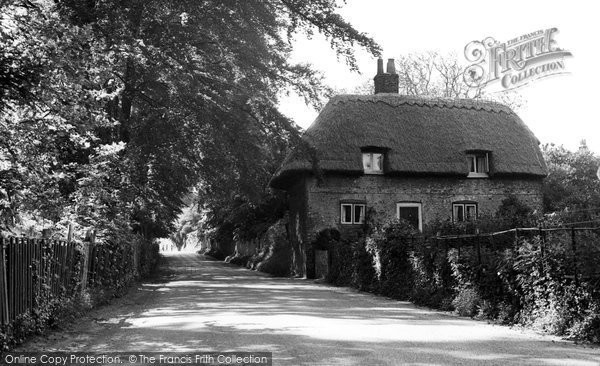Beautiful In All Seasons
A Memory of Eastry.
This road, as the word Brook Street most clearly implies, leads down from the Cross in the distance at the top of the hill down through this avenue of trees to the Lynch. On the left are some beautiful houses with lawns and beautiful trees surrounding them. On the right is a sheep meadow and a horse chestnut tree where we used to go and throw things at the conkers to get them down. These were prize conkers and gave us a serious battle hobby of playing conkers for many weeks during late October and November. Behind the photographer is the Lynch and Lynch House, in which lived Wing-Commander Stanford Tuck who was a valiant and very famous second world war Spitfire pilot. At the bottom of the hill to the right was also a pond, and so there is plenty of water to be found at the bottom of this chalk hill where the waterline is at the surface. Then from the valley floor rose another hill called the Lynch which we think is a word from old English. We assume that these terraces were sculpted in the hillside pre-Saxon times times in order to assist with holding water for crops on this chalky hillside. Presumably, in wet weather, there were also ways to assist drainage. When it snows these terraces are the ideal areas for everyone to come and do their sledging. The word Lynch lets us guess that these terraces were cultivated over 2000 years ago and the Roman Road through Eastry reminds us that Eastry's history is at least as long as that. With the gold cup being found at Ringlemere and the naming of Woodnesborough village being after the Norse god 'Woden' then there is plenty of reason to believe that the history of Eastry, Worth and Ham also dates back to the bronze ages. The sea coast was a lot different then and closer to these villages and these flats at the bottom of Eastry's hillsides were vital for fresh drinking water supplies. This road eventually leads on to the Donkey, a rural pub, and there are several homes with a well in order to reach down for water supplies. The sandy soils and pebbles nearby give the clue that Eastry was virtually on the coast. These days this soil is ideal for hop growing and so oast houses were built. The beautiful thatched cottage/house helps to make Brook Street very picturesque and the whole street has a history of showing that this area was actively inhabited throughout periods dating back to pre-Roman times. Nearby is Eastry Court and Palace, The Norman church of St Mary's, the Roman Road, the Lynch, the pubs for stabling horses and Eastry is half way between the Roman castles of Richborough and Dover. This part of Kent has been important for over 2000 years, strategically, for agriculture and politically. The supply of fresh water at the foot of the chalk dip and scarp no doubt has led to this. A watering hole. Quite literally, Eastry has plenty of history yet to be dug up. There is a history in many of the words: Woodnesborough (Woden), Brook Street, Mill Lane, St Mary's, Eastry Palace, Eastry Court, Felderland, Coach and Horses, the Five Bells at the Cross, The Bull, The Plough, the Gunpark, The Caves, The Workhouse, Sandwich, Ham and the Cinque ports nearby testify to ancient and modern and everything between.
Add your comment
You must be signed-in to your Frith account to post a comment.
Add to Album
You must be signed in to save to an album
Sign inSparked a Memory for you?
If this has sparked a memory, why not share it here?


Comments & Feedback
Be the first to comment on this Memory! Starting a conversation is a great way to share, and get involved! Why not give some feedback on this Memory, add your own recollections, or ask questions below.